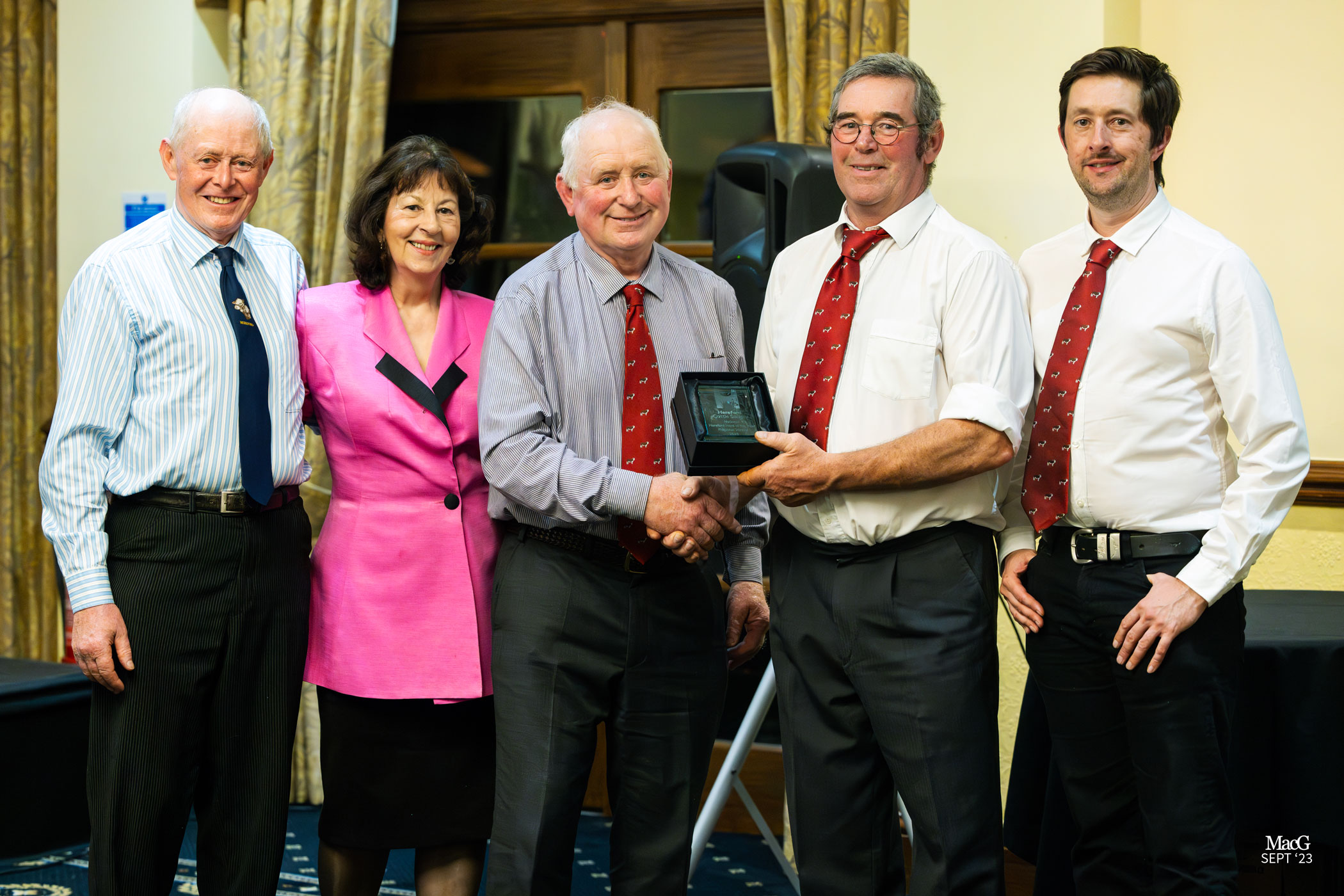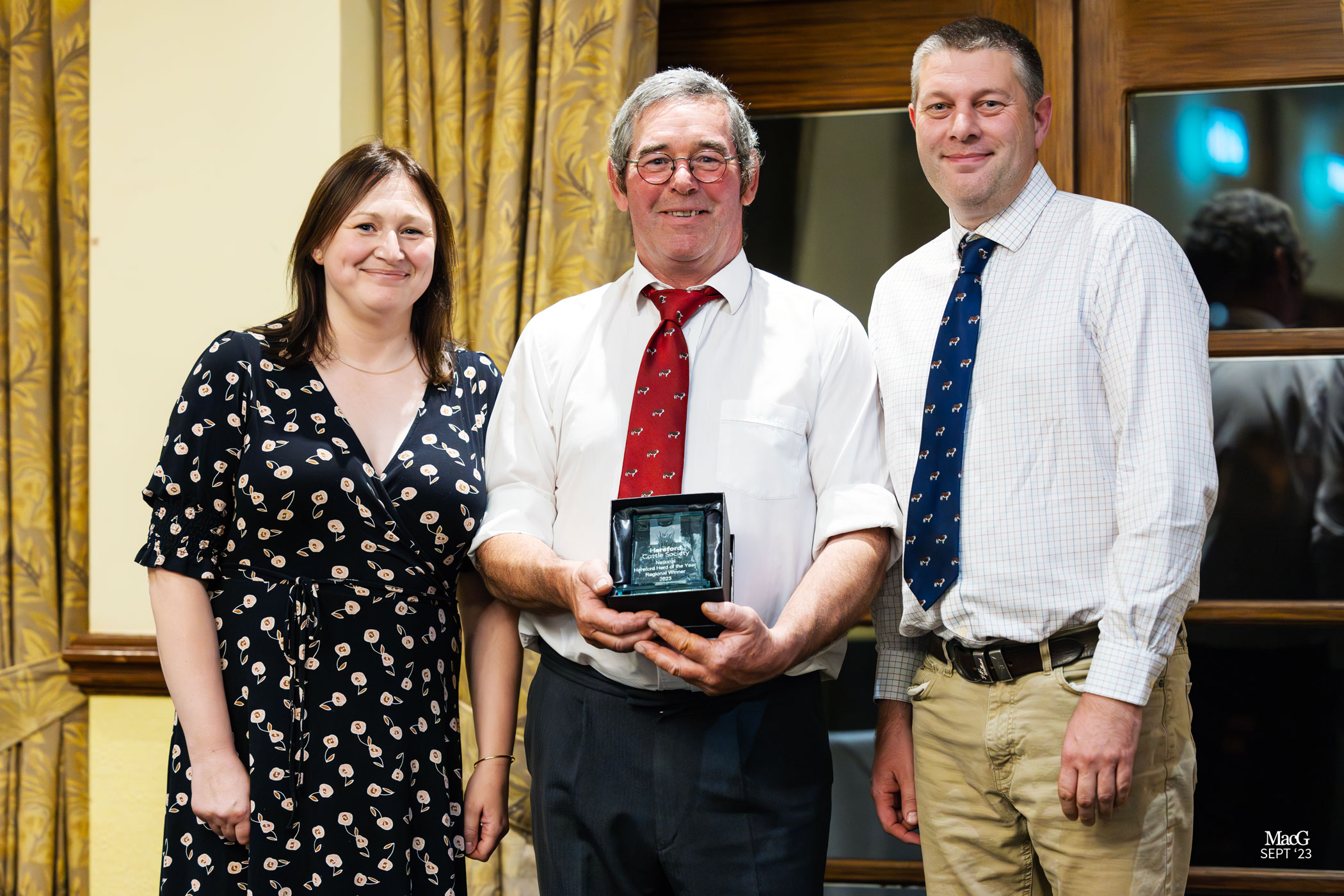
Monday 2 October 2023
This year, judges up and down the country visited herds within regional associations and Hereford clubs to determine which of their members had the best herd. It’s an opportunity for breeders to not only showcase their breeding stock but also their systems, farmland, and plans for future changes. Those lucky enough to be spotted as the associations top pick are then brought forward to partake in the national herd of the year competition.
Judging the national herd competition is no mean feat, setting aside personal commitments to travel the width and breadth of the United Kingdom and Northern Ireland to assess nine herds. Invited by the Hereford Cattle Society council to take on the mantle was husband and wife team Davie and Kate Dickinson. Not known as a couple to shy away from a challenge, they happily accepted and were excited to see what was on offer from fellow breeders.

Judges Davie and Kate Dickinson with David Smyth, Hereford Cattle Society President
Davie Dickinson began his farming career by breaking away from the traditions of his family to pursue his own passion. He started as a shepherd, adding shearer and then sheep scanner to his CV. His skills were not only in demand in the UK but also New Zealand, allowing him 13 years of travelling from country to country. Here started his love and appreciation for the breed having seen large herds of Herefords on his travels.
Having been born into the farming life, Kate Dickinson continued her links within agriculture working from MAFF, DEFRA and the Poultry Club of Great Britain and currently for the British Free Range Producers Association as the membership and event manager. It was during her time as an inspector for MAFF, that she headed up the drive of a small holding, selected for an inspection, to meet its occupant, Davie Dickinson. The premise of a romantic comedy, Kate reprimanded Davie as he had written his movement records in pencil. The pair must have made a lasting impression from this meeting as few months later they met again, this time in a local nightclub and have been together since.
Both determined to continue ahead in farming, wanting to secure a plot of land to expand their enterprise, they applied for farming tenancies. After multiple unsuccessful attempts the two took the leap purchasing land of their own.
Chattlehope House was 400 acres of bare hill ground when they first purchased it 17 years ago. Since then, the couple have improved its infrastructure with the addition of buildings, including cattle housing and a muck store along with a family home which they now share with their 15-year-old daughter, Nina. Set 1,000 feet above sea level at the top of the Pennines in Northumberland close to the Scottish border, the farm is completely off grid.
The farm is ring fenced with forestry which prevents nose-to-nose contact with neighbouring farms but enhances the local insect population. Sitting above the snow line the farm often lies white for several weeks at a time. They have a higher-than-average rainfall, the ground is clay over peat and there is a peat bog on the farm. Despite all these challenges the family and their pedigree Hereford herd are thriving. At the annual awards dinner, Kate gave insight into their farm, and its challenges, finishing with the statement. “It may not be the easiest or the best farm in the land, but it is ours.” As she finished the sentence, she was met with applause from the room, in support and understanding. A moment that felt profound.
Kate put great emphasis on Chattlehope in her presentation as it has set the foundation for their judging criteria and gave the audience which included those whose herds, they visited context to their decision. Davie and Kate both decided before heading out that they were looking for a consistent herd with naturally fleshing cows, producing quality calves. They would take into consideration farm types. Expecting variation from farm to farm, they wanted insight into how the land was being managed to suit the unique needs and ecosystem of each, as well as any environmental sustainability initiatives being undertaken with particular focus on management of grassland and improvements. All of this alongside a long list of questions surrounding herd husbandry spanning insemination to health schemes.
As Kate concluded with what she described as the ‘Winning formula’ she moved ahead reviewing the nine herds she’d visited with Davie and later due to illness, without Davie. Touching on areas of interest from each, showcasing animals within the presentation on screen.
The area winners were.
- Scottish Hereford Breeders association winners – Iain Wilkinson
- South of England Hereford Breeders Association – Messrs Myers
- Midlands & East Anglia Hereford Breeders Association – PRJ & LR Vincent
- Traditional Hereford Breeders Club – P Holloway
- Southwestern Hereford Association – JD Moorhouse
- Wales Hereford Club – TG, EI & EN Thorne
- Hereford Cattle Breeders Association – EL Lewis & Son
- Northern Ireland Hereford Breeders Association – Alan Shaw
- North of England Hereford Breeders Association – W & R Kemp & Sons
Thanking all families and herd owners for hosting the Dickinson on their judging journey. The top three winners were announced.

Messrs Kemp of Auckvale Herefords in County Durham
In third places, with a herd that showed exceptional consistency and confirmation throughout especially considering the size of the herd, Messrs Kemp of Auckvale Herefords in County Durham.

Laura and Phillip Vincent, Pulham Herefords
The second-place position was awarded to Laura and Phillip Vincent, Pulham Herefords again producing a herd which had great cow consistency, condition and conformation and with breeding prize winning young stock.

Taking first place Non Thorne, for TG, EI & EN Thorne, Studdolph Herefords
As the applause died down, the room of more than 120 heads sat quiet, awaiting the final decision and announcement from Kate. The winners of the National Herd Competition for the second time in a row, hailing from Pembrokeshire in Wales, with 45 Polled and British polled cows within their herd were the Thorne family, Studdolph from Wales.